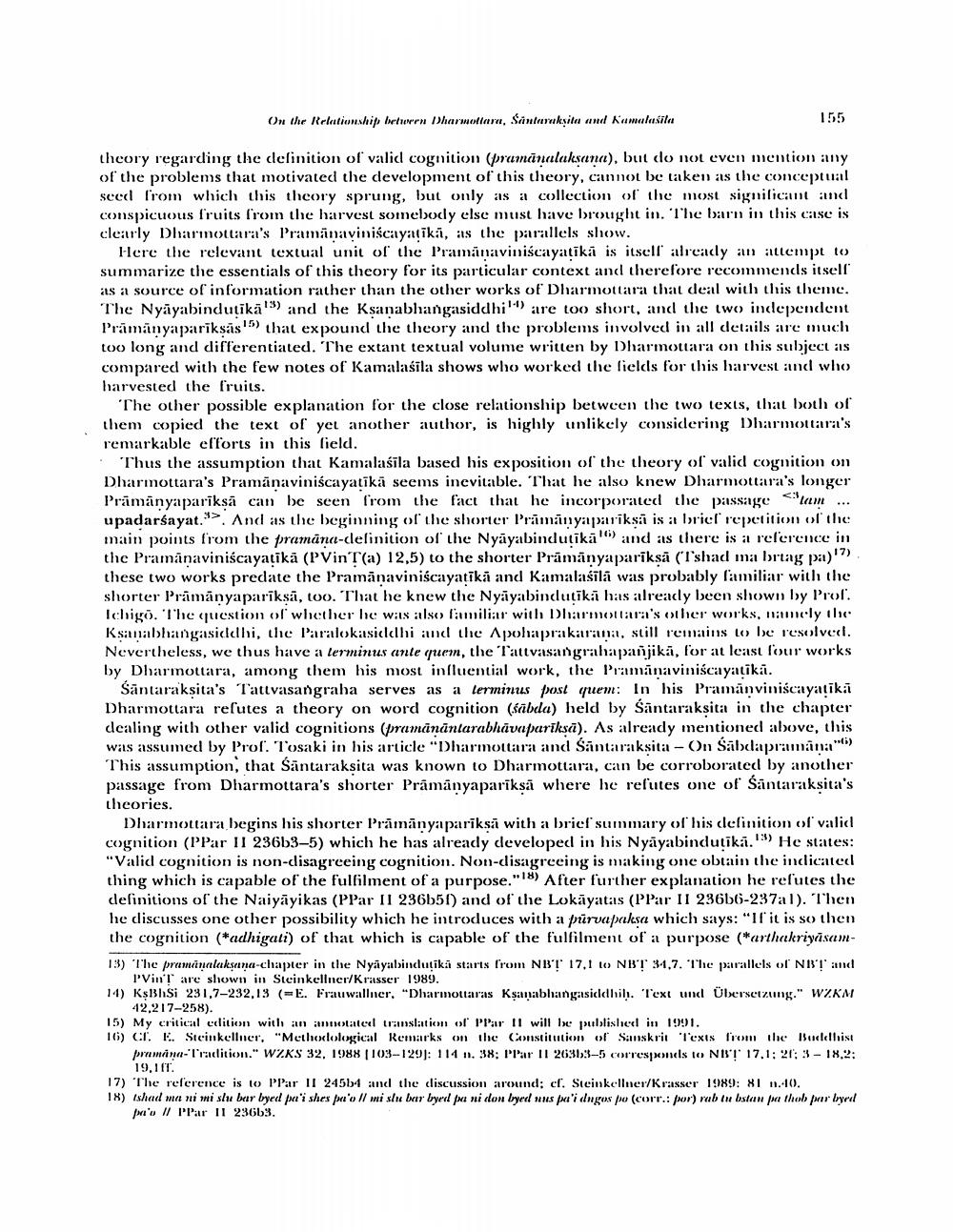________________
On the Relationship between Dharmottara, Santaraksitu and Kamalasila
155
theory regarding the clefinition of valid cognition (pramanalaksana), but do not even mention any of the problems that motivated the development of this theory, cannot be taken as the conceptual seed from which this theory sprung, but only as a collection of the most signilicant and conspicuous fruits from the harvest somebody else must have brought in. The barn in this case is clearly Dharmoltara's Pramanaviniscayatiki, as the parallels show.
Here the relevant textual unit of the Pramātaviniscayatika is itself alreadly an attempt to summarize the essentials of this theory for its particular context and therefore recommends itself as a source of information rather than the other works of Dharmottara that deal with this theme. The Nyāyabindutikā") and the Ksanabhangasiddhil) are too short, and the two independent Prāmānyapariksas's) that expound the theory and the problems involved in all details are much too long and differentiated. The extant textual volume written by Dharmottara on this subject as compared with the few notes of Kamalasila shows who worked the fields for this harvest and who harvested the fruits.
The other possible explanation for the close relationship between the two texts, that both of them copied the text of yet another author, is highly unlikely considering Dharmottara's remarkable efforts in this field.
Thus the assumption that Kamalasila based his exposition of the theory of valid cognition on Dharmottara's Pramānaviniscayatīkā seems inevitable. That he also knew Dharmottara's longer Prāmānyapariksă can be seen from the fact that he incorporated the passage am ... upadarśayat.. And as the beginning of the shorter Pramanyapariksã is a brief repetition of the main points from the pramāna-clefinition of the Nyāyabindutikā") and as there is a reference in the Pramānaviniscayatika (PVin T(a) 12,5) to the shorter Prämänyapariksa (Tshad ma brtag pa)'7) these two works predate the Pramanaviniscayatika and Kamalasila was probably familiar with the shorter Prämānyaparīksā, too. That he knew the Nyāyabindutika has already been shown by Prol. Ichigo. The question of whether he was also familiar with Dharmotara's other works, namely the Ksanabhangasilahi, the laralokasiclathi and the Apohaprakarama, still remains to be resolved. Nevertheless, we thus have a lerminus ante quem, the Tattvasangrahapanjikā, for at least four works by Dharinottara, among them his most influential work, the Pramanaviniscayatika.
Santaraksita's Tattvasangraha serves as a terminus post quem: In his Pramänviniscayatika Dharmottara refutes a theory on word cognition (sābda) held by Santaraksita in the chapter dealing with other valid cognitions (pramanāntarabhāvapariksa). As already mentioned above, this was assumed by Prof. Tosaki in his article "Dharmottara and Santara ksita-On Saldapramâna This assumption, that Säntaraksita was known to Dharmottara, can be corroborated by another passage from Dharmottara's shorter Prämânyapariksā where he refutes one of Santaraksita's theories.
Dharmottara begins his shorter Prāmānyapariksa with a brief summary of his definition of valid cognition (PPar II 236b3-5) which he has already developed in his Nyayabindutika." He states: "Valid cognition is non-disagreeing cognition. Non-disagreeing is making one obtain the indicated thing which is capable of the fulfilment of a purpose."18) After further explanation he refutes the definitions of the Naiyāyikas (PPar II 236b51) and of the Lokāyatas (PPar II 236b6-237al). Then he discusses one other possibility which he introduces with a pūrvapaksa which says: “If it is so then the cognition (*adhigali) of that which is capable of the fulfilment of a purpose (*arthakriyasan13) The praminalaksana-chapter in the Nyayabindulika starts from NBT 17,1 to NIT 34.7. The parallels of NB! and
PVint are shown in Steinkellner/Krasser 1989. 14) Kshsi 231,7-232,13 (=E. Frauwallner, "Dharmottaras Ksanabhangasiddhib. Text und Übersetzung." WZKM
42,217-258). 15) My critical edition with an imeotated tramslation of PPar 11 will be published in 1991. 10) CI. E. Steinkellner, "Methoclological Remarks on the Constitution of Sanskrit "Texts from the Bullhist
pramina Tradition." WZKS 32, 1988 103-129): 114 11. 38: Par 11 263135-5 corresponds to NIS! 17.1; 21: 3 - 18.2:
19,16T. 17) The reference is to PPar II 245b4 and the discussion around: cf. Steinkellner/Krasser 1989: 81 11.-10. 18) Ishad ma ni mi slu bar byed pa'i shes pa'o Il mislu bar byed pa ni don Dryed uus pa'i dngos po (corr.: por) rab tu bstam pa thob par lyril
po Il PPar 11 236b3.




